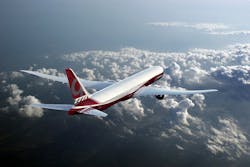Operational Effects of Folding Wing Technology
The Boeing Company’s 777x will be the first twin-engine jet to haul a jumbo jet’s payload of 400 passengers. While the aircraft’s 223-foot wingspan would normally restrict it to about a dozen airports worldwide that have taxiways and parking positions large enough to accommodate jumbo jets, the 777x has been outfitted with wingtips that fold in when the plane is on the ground and unfold at take-off. This folding wing technology allows the 777x to function as a Group VI size aircraft in the air and park at gate facilities designed for smaller Group V aircrafts.
This folding wing technology has been around for awhile; the U.S. Navy has used it for decades to fit large airplanes onto cramped aircraft carriers. Commercial aircraft manufacturers have been slow to adapt the technology for passenger transport based on the fuel-burning weight required. Boeing’s solution to lighten the load was to borrow a carbon fiber based composite wing design from its 787 Dreamliner. The 777x is the first commercial passenger airplane with folding wing technology approved for use by U.S. regulators.
Airline and airport officials alike are understandably excited about the new Boeing design that will enable airlines to deliver more passengers to more airports with minor changes to infrastructure. However, to ensure smooth operations, airport designer Hugh Weaver encourages airports to take a holistic approach to accommodating these larger planes.
“We need to look at how these new planes impact the airfield as airport designers and operators,” he said.
Weaver, who has worked with airports across the world for more than 30 years, is Vice President of Aerospace at Pond, an architecture, engineering planning and design firm headquartered in Georgia. He has “seen it all” in his work across four continents and three decades and said that while Boeing’s folding wing technology is exciting, it isn’t infallible.
“Runways, taxiways, pavement and buildings all have to be designed to accommodate these aircrafts whether the wings retract or not. The last thing you want is for everything at a busy airport to come to a standstill because one plane is malfunctioning,” Weaver said. “We want to minimize interruption to the ongoing operations of the airport.”
That means looking at all possible scenarios to ensure the plane and the increased number of passengers it carries can be accommodated. Airports designed for traditional Group V aircrafts may not have considered impacts to operations from these new hybrids, Weaver said.
As it relates to the airfield, a departing 777x can operate on a Taxiway Group V pavement from the gate to the departure hold position with its wings retracted. A departure release command given by air traffic control would authorize the pilot to extend the wingtips near the end of the runway. The 777x would then taxi to the runway and take off as a Group VI aircraft.
If the wingtip extension fails on one or both of the wingtips, the aircraft must then move to a “penalty box” area. “This area gives the aircraft a place to park off the taxiway until it can be serviced or marshalled to a maintenance area and allows continued access to the departure runway for other airport operations to continue,” Weaver said.
When landing a 777x, the flight crew would activate the aircraft’s computer for landing retraction before touchdown. Once the maingear touch down and the airspeed reduces to a preset condition, the wingtips would automatically retract, allowing the airplane to exit the runway and taxi as a Group V operation.
“Should the wingtips not fully withdraw, the aircraft would likewise need to occupy a ‘penalty box’ area sited to allow continued access to exit the arrivals runway for other operations,” Weaver said. "Airports should also be mindful of other operational impacts on the airfield,” said Weaver. This includes functionality of wing articulation during icing conditions and access to deicing pads with wings in vertical position.
The folding wing technology of the 777x may present challenges for airport operators at the concourse as well, Weaver advised. Gate areas sized for Group V aircrafts may provide seating for 250 to 300 flyers whereas the Group VI-sized 777x can park in a Group V gate and enplane 400 passengers.
“Concourses may be significantly undersized to accommodate passengers for these flights,” Weaver said. “Such overcrowding also will be noticed at the concourse restrooms after an arriving 777x deplanes.”
Boeing predicts that global air traffic will grow five percent a year over the next two decades, contributing to gate gridlock and increased delays at the world’s busiest airports. As the demand for air travel continues to grow, the 777-9x offers a promising solution: to deliver the same number of passengers as the massive Airbus A380, but, with its folding wing technology, fit into existing gates meant for smaller planes.
Airport operators should think twice before dismissing the folding wing planes as a non-impact for their airport. Weaver said that Boeing has hinted that if folding wing technology is successful on the new 777-9x, the company will begin to evaluate its application to the ever popular 737 series. This would bring a new Group IV aircraft to operate at Group III airports and impact an entirely different market of operators.
While airlines, airport regulators and planners agree this folding wing technology is a great idea, airport infrastructure challenges could become a headache if not proactively acknowledged and resolved.
Hugh Weaver works as Vice President over Ponds Aviation division has over 30 years of strategic and comprehensive project management, planning, and engineering design experience for complex capital improvement programs. His varied aviation expertise affords the ability to oversee all facets of a project’s scope of work, while keeping the big picture in mind.




